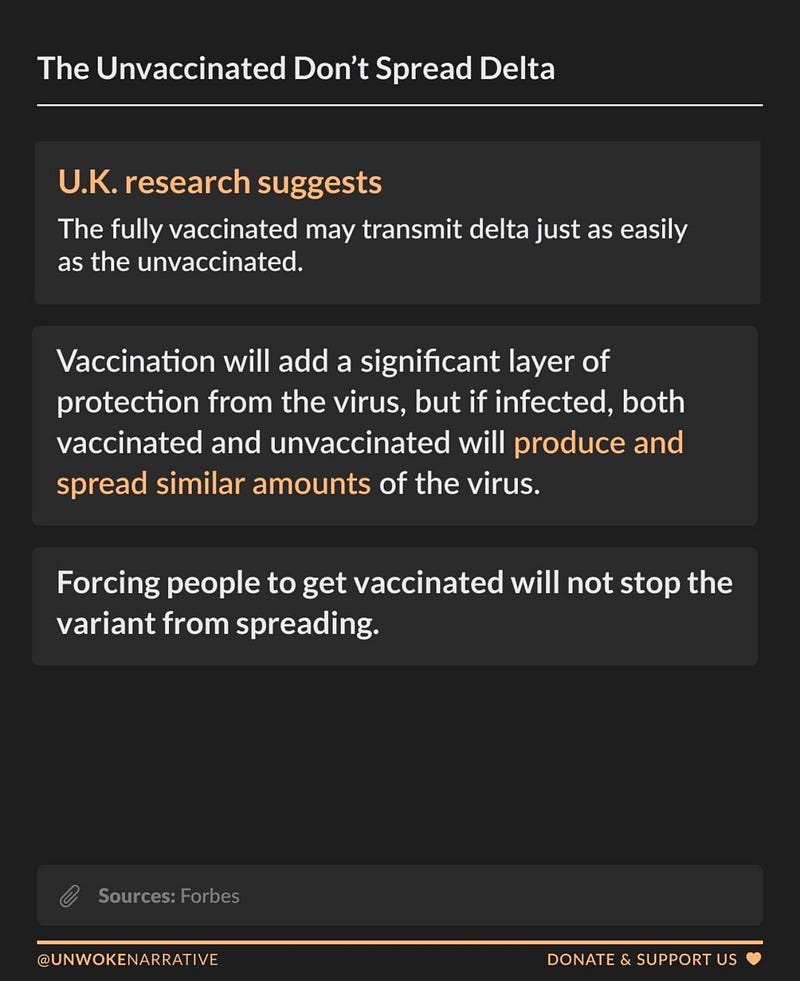Understanding the Spread of COVID-19: Vaccinated vs. Unvaccinated
Written on
Chapter 1: The Delta Variant Data Leak
Recently, internal CDC statistics regarding the Delta variant were made public, revealing crucial insights. One significant takeaway was that Delta has a much higher transmission rate compared to the original COVID-19 strain.
However, a specific detail caught the attention of the anti-vaccine movement: the viral load present in the nasal passages of infected vaccinated individuals appears to be similar to that of their unvaccinated counterparts.
This discovery leads to an important consideration: since COVID-19 is primarily transmitted through respiratory droplets, the implication could be that, under certain conditions, vaccinated individuals might transmit the virus just as effectively as unvaccinated ones.

Chapter 1.1: Misinterpretations and Assumptions
The anti-vaccine narrative has taken this finding and drawn misleading conclusions. It is essential to clarify several assumptions made by these claims.
Firstly, we do not know if the equivalence in viral load translates to equal transmission rates. Are the viral particles in vaccinated individuals neutralized by antibodies? Furthermore, is the nasal viral load the most accurate predictor of transmissibility?
For the sake of argument, let’s assume that:
- Nasal viral load accurately reflects transmissibility.
- Infected individuals, regardless of vaccination status, possess equivalent nasal viral loads.
Even with these assumptions in place, the assertion that "mandatory vaccinations will not halt the spread of variants" is fundamentally flawed.
Chapter 1.2: The Importance of Context
It’s crucial to remember that not all factors are equal when discussing the implications of viral load studies.
Let’s delve into two hypothetical groups, each consisting of 10,000 individuals:
- Group A: 10,000 unvaccinated individuals, with an anticipated infection rate of 0.88%. From this group, we would expect around 88 infections. Assuming a reproductive number of 3, each infected person could potentially spread the virus to three others, leading to a rapid escalation of cases.
- Group B: 10,000 vaccinated individuals, where the infection rate is 0.04%. This results in just 4 initial infections. Following the same reproductive rate, these cases will also multiply, but significantly fewer individuals will ultimately become infected.
Despite the similar rates of transmission among infected individuals, the initial number of cases is drastically lower in the vaccinated group, highlighting the importance of considering denominators.
Chapter 2: Assessing Infectiousness
It’s essential to recognize that just because vaccinated and unvaccinated individuals might spread the virus to a similar number of people, it does not imply they will do so equally.
In the previous example, we assumed the reproductive number remained constant across both groups. However, this is only applicable when both populations consist of entirely susceptible individuals. In the case of vaccinated individuals, many are not completely vulnerable to infection.
For the anti-vaccine claims to hold true, one would have to argue that vaccinated individuals are more contagious than their unvaccinated peers, which contradicts the established understanding of vaccine-induced immunity.
In summary:
- Vaccination significantly reduces the number of infections.
- Even if the few vaccinated individuals who do contract the virus are equally infectious, they face a population of fewer susceptible individuals.
Thus, contrary to the claims made by certain narratives, vaccination indeed plays a critical role in curbing the spread of variants.
The first video titled "VERIFY: Can a fully vaccinated person spread COVID-19 to an unvaccinated person?" explores the nuances of viral transmission between vaccinated and unvaccinated individuals.
The second video, "No, vaccinated don't spread COVID as easily as unvaccinated," addresses common misconceptions regarding the transmissibility of vaccinated individuals.